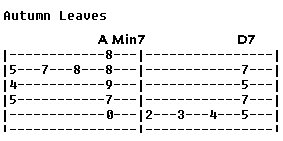|

Custom Search
Walking Basslines put the Swing in Fingerstyle Guitar.
This Terrific Introduction To Walking Basslines Is A Must For The Fingerstyle Guitarist. Learning how to do it isn't as tough as you might think. The first thing that you need to do is to find out how abassline sounds. If you don't know what they sound like, there's no way that you can play them. A great way to do that is by listening to piano trios. Why piano trios? Simple. With just 3 instruments it's easy to hear the bassline. And because the piano is our " chordal cousin " we can hear all of the nice harmonies that are going on. The first thing that you'll notice is that there's an awful lot going on all at the same time. How can one guitar player hope to sound like a piano player, a bassist playing walking basslines and a drummer? The truth is, you can't.
THE SECRETHere's the secret. You create the illusion of playing a lot at one time. In reality the listener's ear and imagination fill in the missing notes. It doesn't really all happen at the same time. It just sounds like it does. Take a look at this portion of Autumn Leaves to see what I mean.

The most important notes are the melody notes. Without the melody you might have some nice sounds but the sounds don't really say anything. The next most important notes are the bass notes. Look at the example below to see what can be done with just the melody and bassline.
WHICH BASS NOTES TO USESo how do you figure which bass notes to play? The first thing to do is look at the bass notes of the chords that you're playing. The root of the chord is where you'll want to start. The target that you're aiming at from that point is the nextchord in the progression. But if you jump from the root of the first chord to the next chord it sounds rough and uneven. Here's how to smooth it out. You can approach your target note from a half step (one fret) above or below the target note. This alone gives a sense of movement to the bass. Whether or not your bassline walks more than that depends on if there is more going on in the melody and chord department or not. If you're playing a little chord or bit of the melody the listeners ear is going to be hearing that and their imagination will be supplying the rest. Another thing to take a look at is the quality of the supporting chords. Let's look back at our example from Autumn Leaves. The first chord is an A minor7. From the A minor7 we walk up to D7. We will want to use notes from the A natural minor scale for this. Here's an example of that scale.
THE STUFF IN THE MIDDLEWhat else should you play besides walking basslines and melody in this type of arrangement? The most obvious choice for harmony notes are the 3rd and 7th notes of the chord. These will help show if the supporting harmony is major, minor or a dominant. If these are new terms for you look back at the page on guitar chords. Besides the 3rds and 7ths you can add any other tones that are pleasing to your ear. Open voiced triads are another good choice. The trick is to not make it so complicated that you can't easily play the song. That will be of no benefit to you and will be painful for the listener.
QUICK TIPSHere are some general guidlines that will make playing walking basslines easier. 1) Limit your basslines to the 5th and 6th strings. Play chords or harmony parts on the 4th, 3rd and 2nd strings and the melody on the 1st, 2nd and 3rd strings. 2) Use easy to grab chords or chord fragments. 3) Use harmonies that make sense in the song. Don't play an extended or dissonant sounding harmony for it's own sake. 4) Listen to music that swings. Walking basslines are usually associated with blues and jazz. Listen to recordings of these types of musics. That will help you learn what it's supposed to sound like. Learning to play walking basslines is an on-going project. Use the ideas in this article and your basslines will be walking and your playing will be swinging. Return to Return to learn-fingerstyle-guitar.com .
|





 Our root note, the A, is played on the open 5th string. Then we begin to play through the scale. Notice that we play the C# at the 4th fret. A C# isn't part of the A minor scale. So why play it? Because it's an approach tone to our target note- the D. It's one fret away from the D.
Our root note, the A, is played on the open 5th string. Then we begin to play through the scale. Notice that we play the C# at the 4th fret. A C# isn't part of the A minor scale. So why play it? Because it's an approach tone to our target note- the D. It's one fret away from the D. 